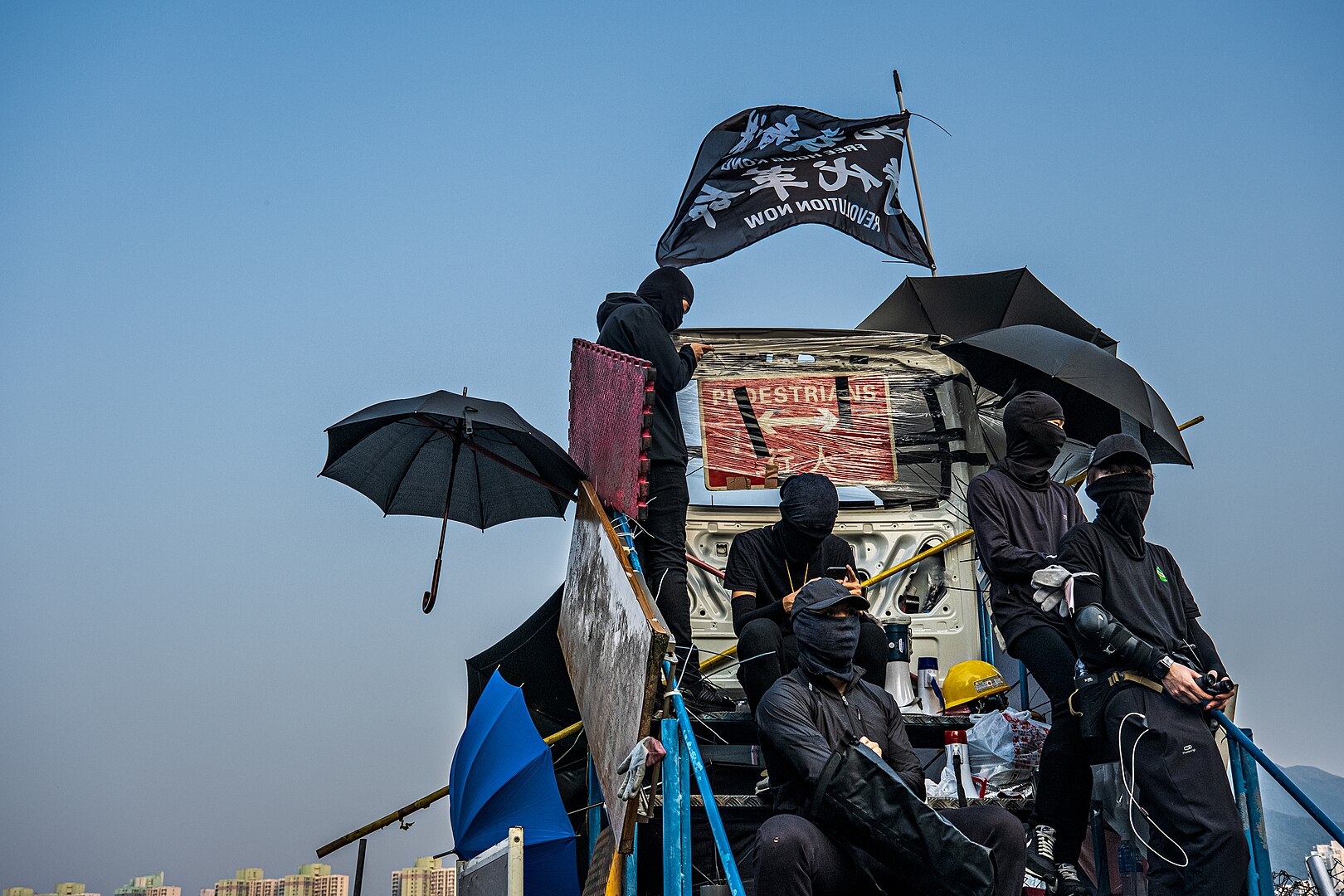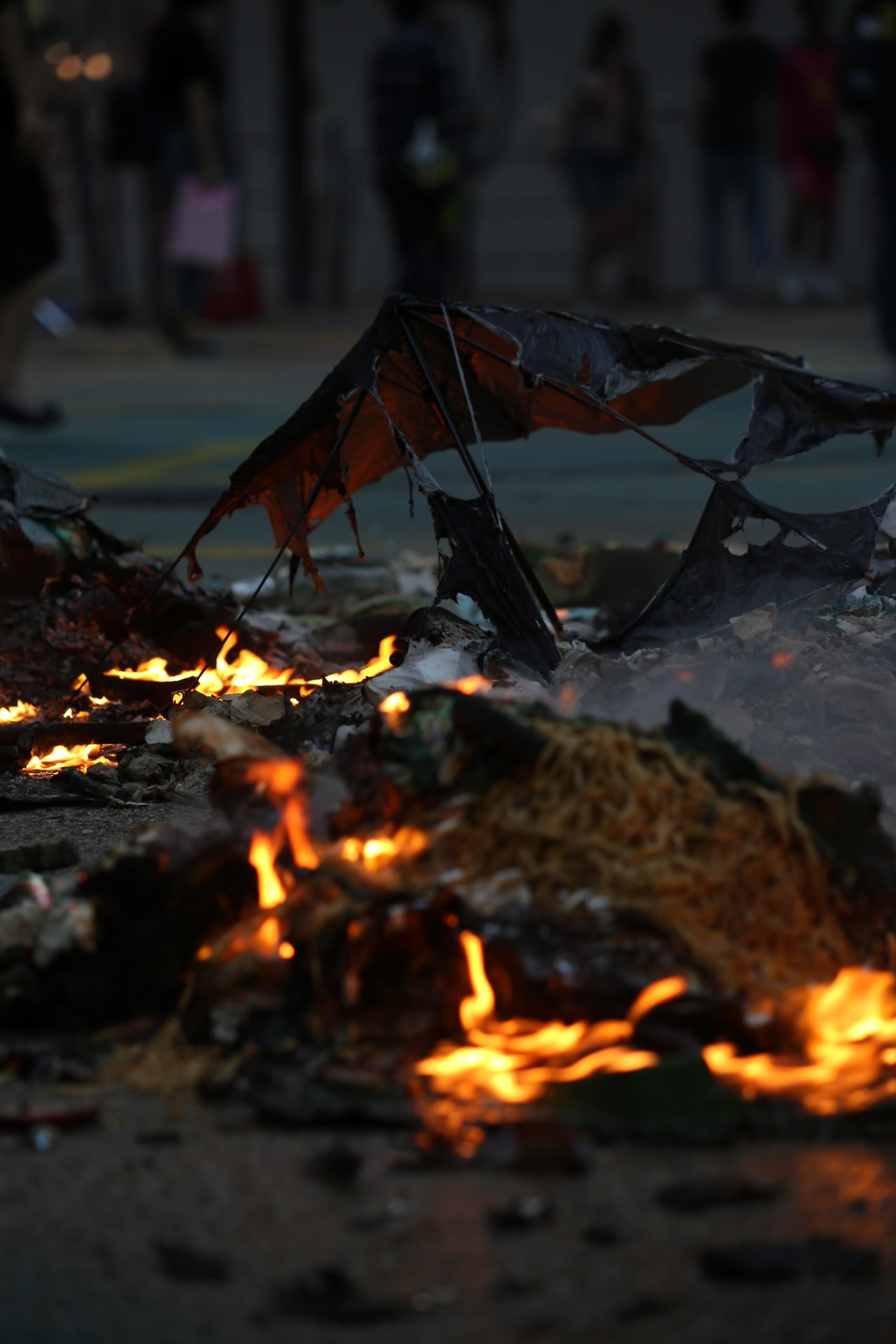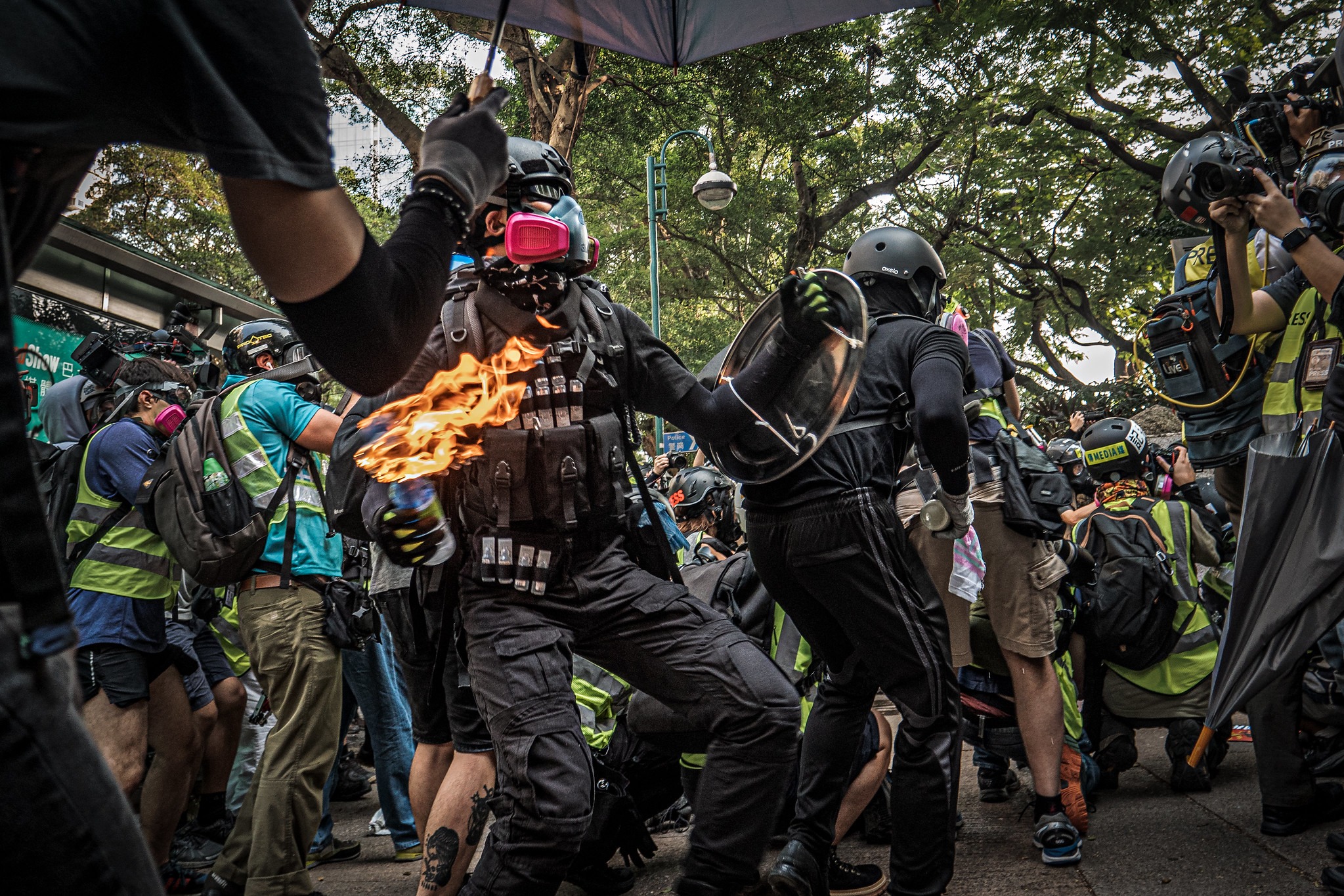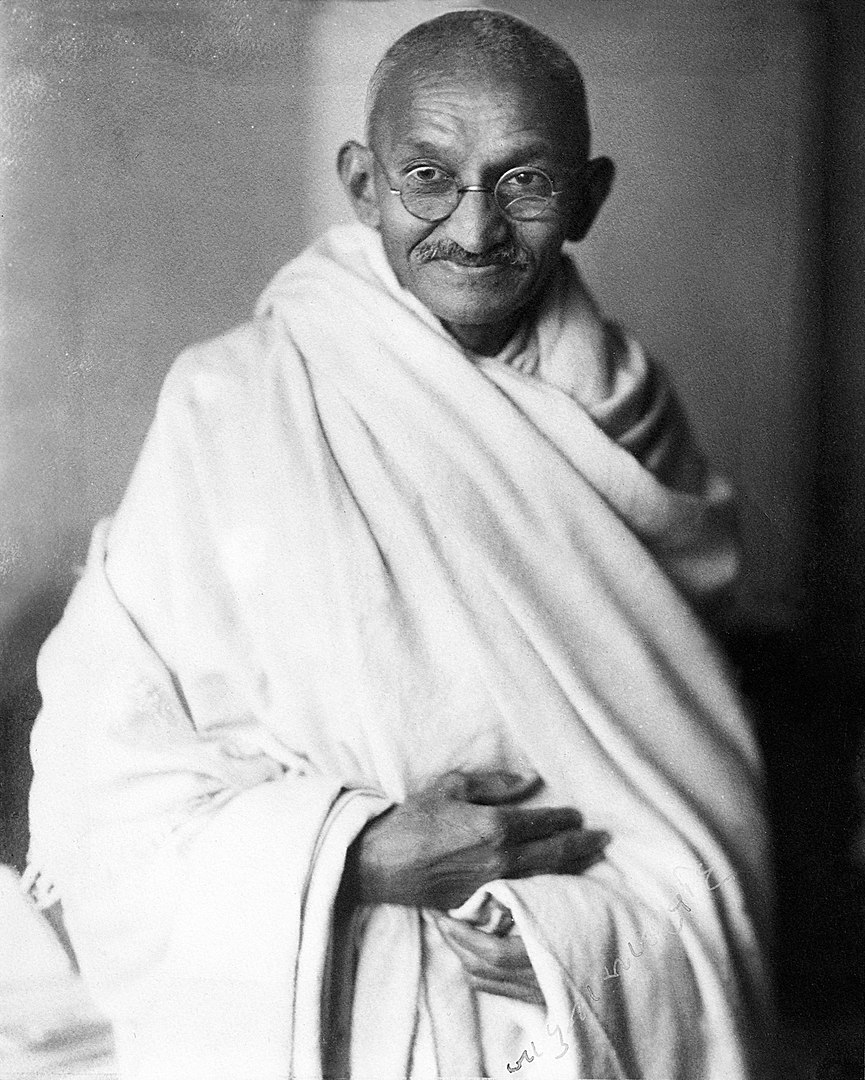Message to Hong Kong Partisans: SPLIT

By Shaun Tan
Founder, Editor-in-Chief, and Staff Writer
21/11/2019

Protestors, some armed with bows and arrows, occupy Chinese University of Hong Kong (Picture Credit: Studio Incendo)
If the symbol of the 2014 Hong Kong protests was the umbrella, the symbol of the 2019 protests may be the petrol bomb. Radical protestors have hurled countless Molotov cocktails at police officers, or lobbed them into subway stations. After protestors occupied the Chinese University of Hong Kong, some 8,000 petrol bombs were reportedly found inside.
This change in symbols exemplifies the degeneration of the protest movement. In the early days, protestors were marked by their conscientiousness, by how they made way for ambulances, picked up after themselves, did no harm to people or property. Now, some protestors seem to be going out with the specific intention to brawl with the police, and on 12th October, a protestor slashed a police officer’s neck with a sharp object.

Protestors torched a traffic blockade and an umbrella (Picture Credit: Katherine Cheng)
It’s not just the police and obvious symbols of mainland Chinese authority that are considered legitimate targets, but anyone deemed to be in league with or sympathizing with them, and so radical protestors have vandalized subway stations, the Bank of China, and other mainland-linked businesses. You can now be attacked by protestors for taking photos of them or disagreeing with them, and some people are even afraid to speak Mandarin in public. Earlier this month, protestors hit an old man who was filming them in the head with a brick, killing him. Most horrific of all, on the 11th, protestors doused a man in flammable liquid and set him on fire after he argued with them. Sometimes there appears to be little method to the madness, as when protestors trashed Festival Walk, a mall owned by Temasek, a Singaporean sovereign wealth fund, and set fire to its Christmas tree (some protestors criticized the mall for allowing police to enter).
Of course, these radicals are only a minority of the protestors, but you’d expect the peaceful majority to condemn them, to excise their taint from the movement. They haven’t. Instead, most seem willing to overlook the abuses on their own side, with some of them explicitly refusing to “split” with the radicals, who they affectionately dub “the braves,” and who have become the defacto militant wing of the movement. In his article in the Financial Times, “Events in Hong Kong reveal the thin veneer of civilization,” Jamil Anderlini noted how the percentage of Hong Kongers who strongly agree the protests should remain peaceful dropped from 65% in June to 46% by mid-October, and that 59% of them now say they “understand” the need for more radical action if peaceful protests fail.
Most protestors seem willing to overlook the abuses on their own side, with some of them explicitly refusing to “split” with the radicals.
This sentiment was most starkly captured in an interview Tim Sebastian of DW News conducted with Joey Siu, a pro-democracy and spokesperson for several Hong Kong student unions. In the interview, Siu repeatedly refused to condemn violent protestors, saying that “one of the principles among the protestors is about no splitting and no condemning any of our protestors, even though the level of violence they use seems to be escalating and might be posing some harm to the others.” When Sebastian brought up the case of a Hong Kong man who was beaten unconscious by protestors after he argued with them and proclaimed “Love China! I am Chinese!” the following exchange ensued:
JS: Of course that would not be the very ideal way.
TS: Ideal? You don’t even condemn it?
JS: We do not condemn any kinds of…
TS: You have no principles, then, if you’re not going to condemn inhuman treatment like this. You can’t even look me in the face and say: “I condemn this kind of inhuman treatment.”
JS: We will not do any kinds of public condemn[ation]. But still we are trying to switch the tactics to a more peaceful way.
Tim Sebastian’s interview with Joey Siu
It should be obvious to peaceful protestors, and all who support them, what a terrible idea the “no splitting” rule is. It should be obvious that you cannot defend Hong Kong’s rule of law (which is what the protests were originally for) and refuse to condemn violent crimes, that you cannot defend Hong Kong’s unique freedoms against encroachment from mainland China and be ok with people being beaten up for their political beliefs or for exercising their civic rights. It should be obvious that you can’t denounce the thuggishness and fascism of the Chinese Communist Party (CCP) and condone it in your own ranks, that you can’t demand accountability from the government without demanding it from those on your side. As Sebastian pointed out, it shows that you have no principles, that you are not committed to the rule of law, or democracy, or human rights, but only to your own tribe. It compromises the movement, and binds it to its worst elements. It makes demonstrators seem less like peaceful protestors and more like rioters, provides support for that favorite argument of the CCP and dictators around the world: that protests inevitably lead to anarchy.

A protestor hefts a petrol bomb (Picture Credit: Studio Incendo)
Indeed, it’s this unscrupulous partisan impunity that the protestors rightly criticize the police and the Hong Kong government for. Over the past few months, there have been serious and credible allegations (as well as some less credible ones) of police brutality. Officers have fired tear gas into a subway station, repeatedly beat cowering protestors, and apparently shot beanbag rounds at such close range and so recklessly that it broke through a protestor’s safety goggles and ruptured her eye. Recent footage shows an officer stomping on a subdued protestor’s head. Yet both the police and the government have rejected the reasonable demand for an independent commission of inquiry to investigate allegations of police brutality. Though they claim to care about the principles of fairness and justice and professionalism, they’re unwilling to hold accountable the bad apples within the force who’ve violated them.
The best thing the partisans in Hong Kong could do now is split. Split and demonstrate that they do have a moral compass, that they can see reason. The alternative is escalating violence, with both sides being dragged to the edge by their most extreme and abusive elements. The eventual result of that will likely be civil war and a crackdown by the People’s Liberation Army.
The best thing the partisans in Hong Kong could do now is to split.
The protestors, for their part, could learn a few things from Mahatma Gandhi, who led the Indian Independence Movement, one of the most effective protests movements in history. During a civil disobedience campaign, local police provoked demonstrators and shot them. When the demonstrators retaliated by lynching the officers, however, Gandhi was horrified, and called off the campaign until “by strict discipline and purification we regain the moral confidence required.”

Gandhi
“No provocation can possibly justify the brutal murder of men who had been rendered defenseless,” he wrote. “[W]hen India claims to be non-violent and hopes to mount the throne of Liberty through non-violent means, mob-violence even in answer to grave provocation is a bad augury…Non-violent attainment of self-government presupposes a non-violent control over the violent elements in the country. Non-violent non-cooperators can only succeed when they have succeeded in attaining control over the hooligans of India.”
Much of the success of the movement was due to Gandhi’s devotion to principle, his insistence on discipline within his ranks, and his recognition of the common humanity of his opponents. Hong Kong’s protestors need not suspend their campaign, but the least they could do is check its abuses.
Or, if Gandhi seems too idealistic for them, perhaps they’ll heed Sun Tzu: Don’t hold a position you can’t defend. If both sides try to defend the indefensible, the city will burn, and all that Hong Kong is, and all it still has, will burn along with it.
